Stephen Costanza’s King of Ragtime
 July 27th, 2021 by jules
July 27th, 2021 by jules
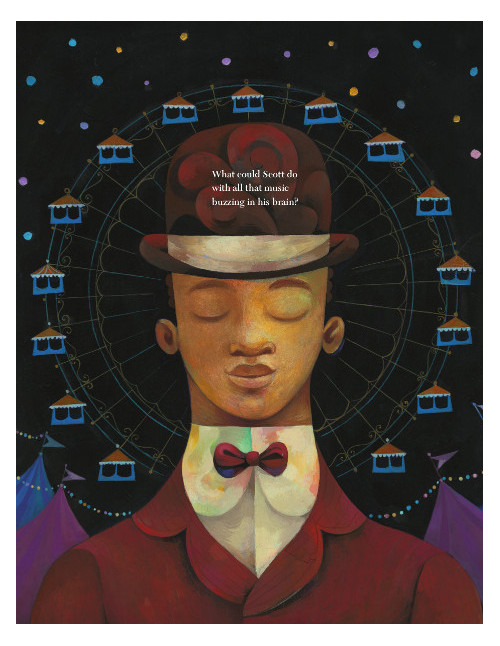
Let me say right off the bat that this post is best read while simultaneously listening to “Gladiolus Rag” (or your Joplin ragtime of choice).
Coming to shelves in September is King of Ragtime: The Story of Scott Joplin (Atheneum) from Stephen Costanza, author-illustrator and one-time ragtime player himself. And it is a beauty.
Joplin was born “in the valley of the Red River.” On Juneteenth, his community was “newly free. Turning to music for solace and celebration, they sang spirituals, and ring shouts, and hollers ….” As a child, Scott’s world was steeped in music. After his family moves north to Texarkana, Joplin’s mother works as a housemaid for a family with a piano. Young Scott is mesmerized and rushes to it when his chores are done. His family manages to buy him his own piano, and Julius Weiss, the owner of the music shop, offers to give Scott lessons in exchange for his mother’s housemaid services. Grown Scott rejects his father’s advice to work on the railroad and heads out instead to play music all along the Mississippi Valley. In 1893, he ends up in Chicago at the World’s Fair. Scott is dazzled by the world’s first Ferris wheel and the lights — but, most of all, the music:
Black pianists weren’t allowed to play at the fair, but in the nearby cafés a red-hot piano sound filled the air. The left hand kep the beat, OOM-pah, OOM-pah! The right hand soared, free as a bird; syncopated, agitated, bodacious, and proud! Folks pranced and danced to a new music called … RAGTIME.
In Missouri, Scott attends school and writes “Maple Leaf Rag,” which will change the course of music history. When, finally, a publisher takes a chance on it, it captivates the nation.
It is here that Contanza chooses to end Joplin’s tale, but a fascinating author’s note fleshes out more detail, particularly post-“Maple Leaf Rag.” In a three-page piece of backmatter that includes a list for recommended listening and a bibliography, he notes that ragtime was the “first great impact of Black culture on the dominant white middle-class culture of America” (though he also notes that many people at the time dismissed it because of its assocation with Black people). Though “Maple Leaf Rag” became the “gold standard for ragtime composition,” a new music called jazz began to dominate, and Joplin — and ragtime — faded in the cultural consciousness. (You can read elsewhere, which this outstanding book prompted me to do, that Joplin was even buried in an unmarked grave. I also recommend further reading about Weiss. Fascinating.) It was the 1970s that brought about a resurgence of the musical form, and Joplin, posthumously awarded a Pulitzer Prize, was recognized as the briliant composer he was.
Note: Part of ragtime’s resurgence in America in the ’70s can be attributed to the LP Piano Rags by Scott Joplin, performed by pianist Joshua Rifkin. Costanza writes fondly in his closing note about his own experience with this as a kid:
His music was seemingly everywhere — the movies, TV, radio — and on the eager fingertips of kids taking piano lessons, like myself. Sales of his recordings reached rock-star levels, but the LP … stopped me in my tracks. It’s an album of eight rags spanning Joplin’s career, and I listened to each piece as if turning a gemstone over and over in my hands.
Costanza, a musician himself, writes with an infectious, exuberant rhythm, often capturing (as in the excerpt above) the sound of the piano’s rhythms. He also sprinkles the text with colloquialisms: “Florence and Giles scrimped and saved, searching Texarkana for a piano, but in the young town a piano was as rare as a two-headed cat.” And the collage illustrations, rendered via gouache and wax pastels? I only have a few pictured here, but when the book hits shelves, I highly recommend you find a copy to take in this beautiful folk art-style artwork. (And since what I’m seeing is a digital copy, I can’t wait to hold the book myself.) Warm earth tones steal the show with many of the opening illustrations featuring patchwork colors for the Red River valley. The three spreads of Joplin at the Chicago World’s Fair, laid out on a pitch-black nighttime background with a Ferris wheel motif dominating, are breathtaking. The way in which Costanza captures the exhaust of a train’s smokestack, while Joplin plays the rhythms of its sounds on his left and right hands: This alone is worth the price of admission.
The book is dedicated, incidentally, to another artistic luminary — author-illustrator Ashley Bryan.
Here are some spreads. Enjoy!
(And when you’re done listening to “Gladiolus Rag,” try Neko Case’s “Ragtime,” a tribute to the form whose lyrics always give me goosebumps.)
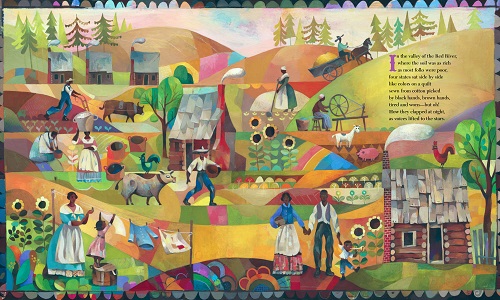
as voices lifted to the stars.”
(Click spread to enlarge)
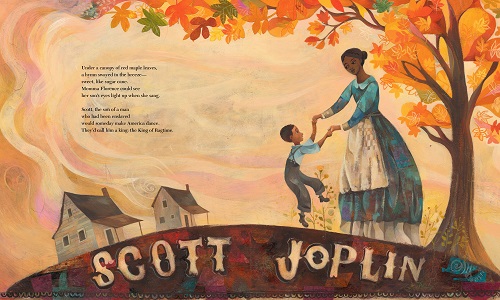
They’d call him a king: the King of Ragtime.”
(Click spread to enlarge)
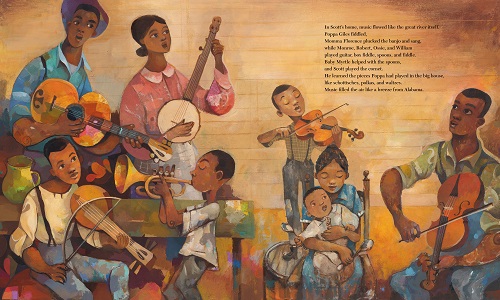
(Click spread to enlarge)
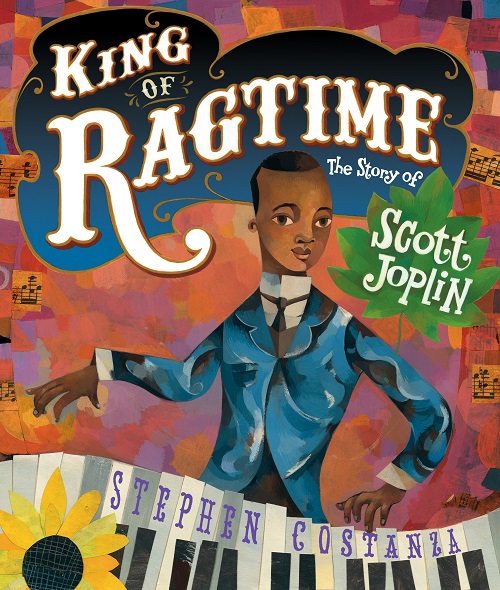
KING OF RAGTIME. © 2021 by Stephen Costanza. Illustrations reproduced by permission of the publisher, Atheneum Books for Young Readers, New York.

Oooh, this looks lovely!